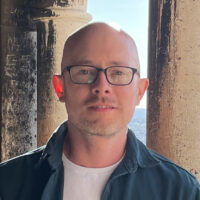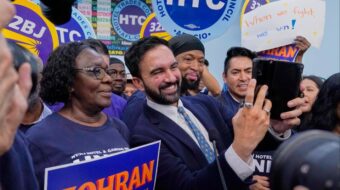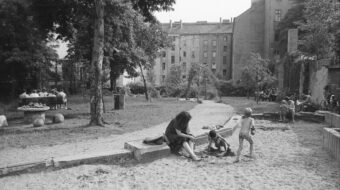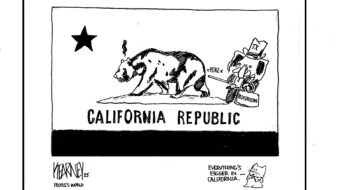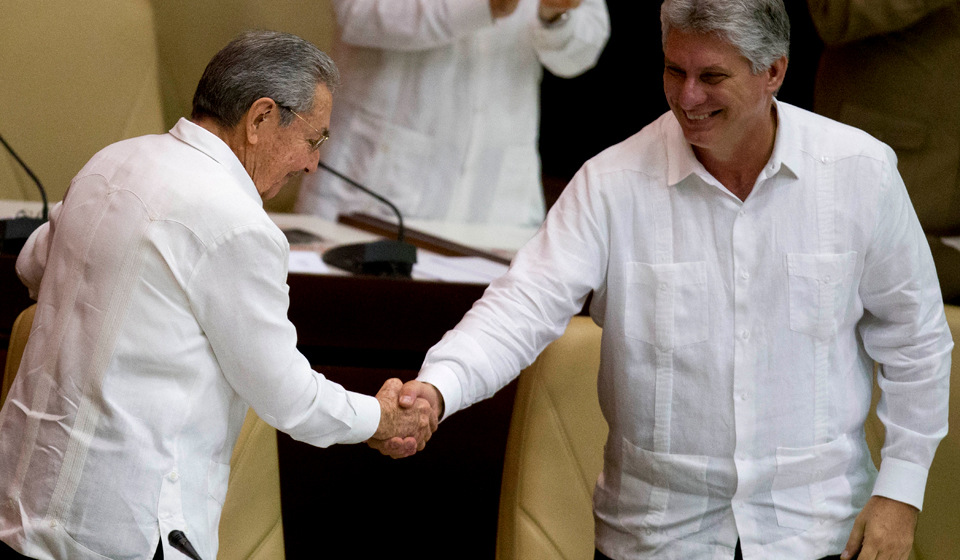
The revolution carries on. That’s the message out of Havana, where 57-year-old Miguel Díaz-Canel is expected to be elected president of Cuba by the National Assembly of People’s Power today, succeeding Raúl Castro, 86.
The 605-member National Assembly, Cuba’s legislature, met on Wednesday and received nominations from the National Candidacy Commission for the Council of State, with Díaz-Canel’s name the only one put forward for the position of president. Along with him are the first black Cuban nominated as first vice president, Salvador Valdés, as well as three women vice presidents. Voting for the Council of State and its officers is the final step in a long process of candidate nominations and elections that stretched back into last fall.
In some 907 local nomination meetings, citizens ended up putting forward a total of 12,000 possible names to the Candidacy Commission. The latter body—headed by the main trade union organization, the Cuban Workers’ Confederation (CTC), and made up of delegates from social organizations in the the women’s, students’ and other movements—then narrowed the list to a slate of 605 recommended National Assembly members. The slate, which reflects measures to ensure diversity of experience, knowledge, race, gender and more, was then returned to locally elected municipal assemblies for an up-or-down vote.
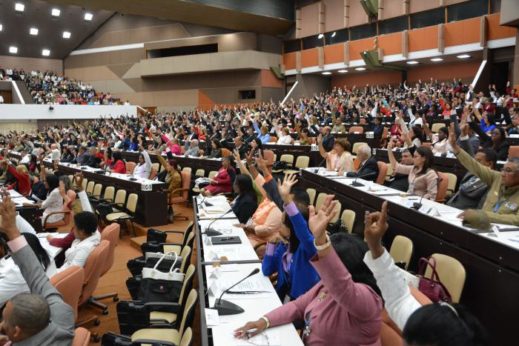
Each name on the list had to receive at least a 50 percent “yes” vote to be elected. Those approved became the members of the National Assembly, which was seated yesterday. The National Candidacy Commission then consulted with the new members to develop a slate of nominees for the Council of State and its top officers—including the president and vice presidents. Nominations were announced yesterday, with voting on that slate taking place today.
The new president
Born after the revolution, Díaz-Canel represents the ascension to leadership of a new generation that cut its teeth in public service in the closing days of the Cold War and during the “Special Period” of economic hardship following the fall of the Soviet Union in the 1990s.
Born the son of a stay-at-home mother and a mechanical plant worker in Placeta in 1960, he was educated as an electronics engineer and went on to serve in the armed forces, participating in a mission in Nicaragua in 1987 as a liaison to the left-wing Sandinista government. Returning to Cuba, he worked for many years in the leadership of the Union of Young Communists (UJC), rising through the ranks to become head of the provincial Communist Party Committee in Villa Clara province by 1994. While there, he gained a reputation among residents as a modest-living public servant dedicated to improving services, even at a time when state coffers were dry.
In 2003, he was elected to the party’s Political Bureau and moved to head up the party organization in Holguín province. By May of 2009, Díaz-Canel was tapped by the government to serve as minister of higher education and eventually vice president in 2012.
The handover of responsibilities from Raúl Castro, who assumed the powers of the presidency when Fidel Castro stepped down due to illness in July 2006, comes at a time of transition for Cuba and its revolution.
A revolution—and an economy—in transition
More than a quarter century after the destruction of its main trading partners in the socialist bloc of Eastern Europe, Cuba is in the early stages of a major rethink of its economic model. For decades, the country had pursued the centrally planned economy that was the hallmark of the Soviet brand of socialism. But for nearly ten years, Cuba has been inching toward a reorientation of its notion of what socialism can and should look like—away from what was learned from the USSR and toward what might be gleaned from the examples of China and Vietnam.
In those countries, a good thirty to forty years have gone into pursuing a market-based model of socialism, where total state ownership of all economic sectors has given way to multiple forms of ownership. Egalitarian wages have been supplanted by pay based on contribution and skill, and bureaucratically determined production goals to supply and demand.
Cuba’s Communist Party first broached the possibility of moving in the direction of a socialist market economy at its 6th congress in 2011 and more forcefully so at the 7th in 2016. Raúl Castro’s report to that meeting, delivered on his behalf by Díaz-Canel, assured party members that “the introduction of the rules of supply and demand is not at odds with the principle of planning.” He said that “both concepts can coexist and complement each other…as has been successfully shown by China…and Vietnam.”
The report approved by delegates went on to declare that the party continued to “aspire to greater efficiency and quality in state sector production,” but it also favored the success of “non-state forms of management”—i.e., the private and cooperative sectors.
But for those among the anti-Cuba establishment in Washington or in the Cuban exile community in Miami who were hoping the launch of market reform would signal the beginning of the end of socialism on the island, Castro quickly countered, saying the “restoration of capitalism” was “not, in the least, the purpose” of the re-conceptualization of socialism.
Since comprehensive reform was begun around 2011 (though some efforts started even further back), change has been steady, but has not kept pace with the goals set by the Cuban leadership—a matter about which the latter are quite frank. Only 25 percent of the 300 reform guidelines set in 2011 have been implemented so far, and the economy only grew by two percent last year—half of what was projected.
In the agricultural sector, long dominated by state farms involved largely in sugar and tobacco production, the government began leasing unused state land to private farmers. More than 150,000 farmers have taken up the offer so far, and there have been some experiments with market-determined prices for crops and livestock, with uneven results. Speculation and inflated prices have forced the delay of some of these trials.
A similar story has played out in the opening of certain sectors of services and small business to entrepreneurs, the “self-employed,” which happened in conjunction with major reductions of the number of state employees. Currently, more than half a million Cubans are licensed as self-employed in services ranging from tourist-oriented industries such as hotel and restaurant operators to domestic-focused services like construction and barber shops. The range of approved licenses is broad, but the identification of a number of problems has led to periodic halts in new issuances.
A tax system has been adopted for the first time since the abolition of personal taxes after the revolution, with new assessments on income, inheritance, major property, and unused farm land. Homes and cars can now be bought and sold, but under strict guidelines, with no one allowed to speculate in real estate. Citizens are limited to owning only a primary residence and a second vacation home.
The withdrawal of Soviet aid after 1991 left Cuba with few international trading partners, a dilemma that was partially eased by increased trade with European countries and especially left-led Latin American nations in the 2000s. But in line with the strategy of most developing countries, the government is emphasizing the necessity of dramatically increasing the amount of foreign direct investment.
A legal infrastructure to facilitate this was put in place in 2014 that allowed some majority ownership by international investors in joint ventures with Cuban state-owned companies. In 2017, the amount of new investment hit $2 billion USD, double what had been seen in any prior year. And in Mariel, a new special economic zone (SEZ), modeled on the Chinese experience, has recently opened. The SEZ incentivizes foreign investors with generous tariff and tax breaks as well as the possibility of 100 percent ownership without the necessity of a Cuban partner.
Finally, in the state-owned sector—the bulwark of the traditional socialist economy—the government is now seven years into a major reorganization effort. State-owned companies, which still account for approximately 70 percent of Cuba’s economic output, previously followed production quotas and price directives handed down from central government ministries. But now they are being given increasing autonomy and pushed to be more independent, operating on a profit-loss basis.
The state says that it intends to continue to move toward a relationship with companies based on regulation and taxation rather than direct management. The Communist Party has made clear that it still affirms “the socialist principle of predominance of the ownership of all the people over the basic means of production,” while relieving the state “of activities not decisive to the development of the nation.”
Among the other major challenges that the party leadership has highlighted is the need to eliminate the country’s disruptive dual currency system, in which different conversion rates prevail within and among state and private sector firms and for salaries. The party argues that getting rid of it is essential to overcoming the productivity problems associated with egalitarian wage systems. With only tiny differentials according to qualification or responsibility, the pay system “generated an unmotivated workforce…and discouraged employees from seeking out positions of greater responsibility.”
Raúl Castro has said compensating workers in a fairer manner, reflecting “quantity, quality, and complexity,” will make it possible to stick to the socialist principle of “From each according to their ability, to each according to their work.”
Challenging headwinds
The path ahead for the Cuban economy will not be easy, however, as the U.S. blockade on the island is being intensified through a diplomatic squeeze by Trump, reversing the openings made by the Obama administration. And Cuba’s allies in Latin America, especially Venezuela, are on the defensive and not as able to assist the island as they were in recent years.
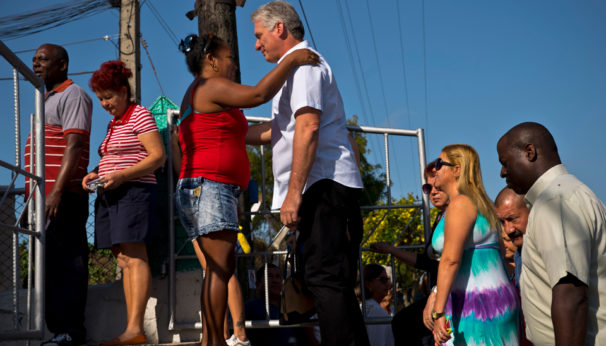
The country continues to develop its highly successful pharmaceutical research and is expanding the tourism industry, a major source of cash. But diversification of the economy is an overriding priority for the government, as it seeks to never be put in a position of dependence on one or only a few commodities, such as sugar and tobacco.
And the growing expectations of Cuban citizens, accustomed to rationed goods and slow economic growth for decades, are also putting pressure on the state. Though eager to preserve the gains of socialism—such as world-class health care and free education—the public also has shown a desire for more and better consumer goods, services, and technology. “Society is demanding more,” as Díaz-Canel has said.
As the public force behind the reforms, Raúl Castro is handing off leadership of the state, but he will remain, for now, as First Secretary of the Communist Party. The transition has set off speculation, especially among the anti-Cuba crowd, that a post-Castro Cuba may also become a post-socialist Cuba.
They are hoping for Gorbachev-style perestroika in the Caribbean and pin hopes on Díaz-Canel being their man. Superficially, it’s an easy tale to weave, with the parallels in official language between the Soviet reform efforts of the late 1980s and those of Cuba today. Such notions, of course, ignore the extent to which major restructuring (within the framework of socialism) has already been pursued for several years now.
With a pledge of ideological continuity on the part of Díaz-Canel and the generation moving up with him, the real question at the current time is not whether socialism is on the way out, but whether younger blood at the top will be able to more forcefully push the reform agenda.


